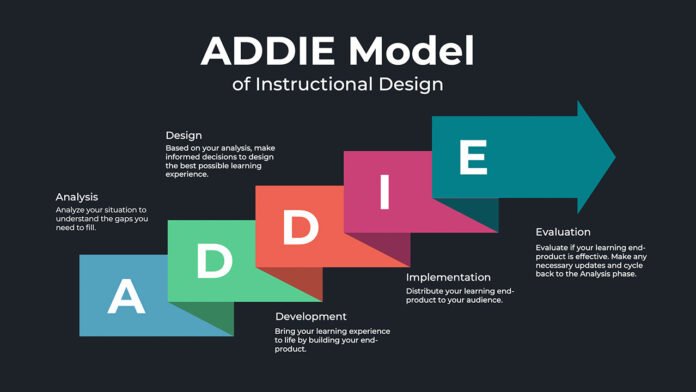Whether you work in the field of education or not, at some point in your life, you will have to teach someone something. You will have to give them instructions. Explain how something works in a way that accommodates their learning style. Or else, they’ll miss out on crucial information and cost you time, money, and frustration.
The ADDIE model of instructional design has been adopted by learners of all ages and industries. It’s lauded for its applicability and ease of use. But what is the ADDIE Model, and how can you use it in your own business or study? Here’s what you need to know.
What Is the ADDIE Model?
Let’s dive in by answering your burning question. What is the ADDIE Model of instructional design? Simply put, the ADDIE model (developed by Florida State University) is a process that instructors and trainers use to develop learning practices that work.
It’s easy to apply for any subject that needs teaching, from company policies to K-12 science to US History 212. And the best part is, it’s flexible and circular. That makes it the perfect instructional model for ever-evolving fields and situations.
Our ADDIE Model guide below will explain each of the steps in further detail.
A Is for Analysis
The “A” part of the ADDIE Model acronym stands for analysis. During this phase, you take a step back and analyze your current situation.
Who are you trying to reach, and what goals do you want to achieve with them? Your aspirations and language, at a minimum, will differ depending on your audience.
You must also analyze what portions of the material must be absorbed, even if all else fails. This calculation must also take into consideration the resources your learners have available to them.
D Is for Design
The first “D” of the ADDIE Model stands for design. This part of the process is where any lesson planning experience you have will come in handy, as it deals with a holistic picture of the course.
During the design phase, you determine what material you intend to teach and when. This is also where you determine what targets you expect your students to reach, how you will test their knowledge, and what resources you will provide for them.
This is not a phase you can gloss over if you expect your training to be effective. Be specific and systematic, or you’ll get lost in the tangled threads of all the material you need to cover before the end of the training/teaching period. While you’re not specifically creating the materials here, you need to know what materials you intend to create.
D Is for Development
The second “D” of the ADDIE Model stands for development. Here is where you take the blueprint that you created during the design phase and flesh it out like an artist rendering more detail onto a sketch. During this portion, you actually create the content that you decided you needed for each section of the course.
During development, you write up worksheets, prompts, and tests. You assemble video links and PowerPoints for your students to use as references. You plan and draft the activities that will work best for the learning styles of your group. If your needs intertwine with electronic learning, this step is when you would upload materials or work with the existing tech to integrate them into the coursework.
By the time you’re done with this step, you should have all the materials you could ever want to present to your students at the ready.
I Is for Implementation
The “I” in the ADDIE Model stands for implementation. Remember all those lessons, assignments, activities, and tests that you spent ages preparing? Here’s where you actually put them into practice.
During implementation, you have to translate your ideas and the facts you need to teach into effective deliveries. This means having plans in mind to avoid veering off-course during the lesson. It also means knowing how to summarize all of your information in a way students or trainees can understand and review.
Implementation is also where you dive into the psychology of your team to figure out what motivates them. You may be able to sort out the best way to inspire them by following these problem-solving templates. Otherwise, if you try to instruct an unmotivated group, you will not see the results you need to see.
E Is for Evaluation
The “E” in the ADDIE Model stands for evaluation. During the evaluation phase, you look back on the effectiveness of the course or lesson to sort out what worked and what didn’t.
Was a certain part of your lesson lacking in research? Did the course feel like it tried to cram too much information too fast? By answering these questions, you can tinker with other parts of the process to get better outcomes in the future.
You should remember, however, that ADDIE does not exist in a chronological space. It’s not a straight timeline. Rather, it circles and loops back on itself, allowing for continuous refinement at all stages. This makes it easy to adjust on the fly in chaotic settings like a rowdy classroom or a busy factory floor.
Understanding the ADDIE Model: Reviewed
The ADDIE model is an effective teaching tool that’s applicable to every industry. Whether you’re trying to teach a child to read or debrief your team on the latest data security procedures, our ADDIE Model tips should help you prepare instructional material that gets the job done.
We hope you found this ADDIE Model guide helpful. If you’d like to read more articles like this one, then check out the Education section of our blog. We update each day with more organizational tips and tricks like this!








